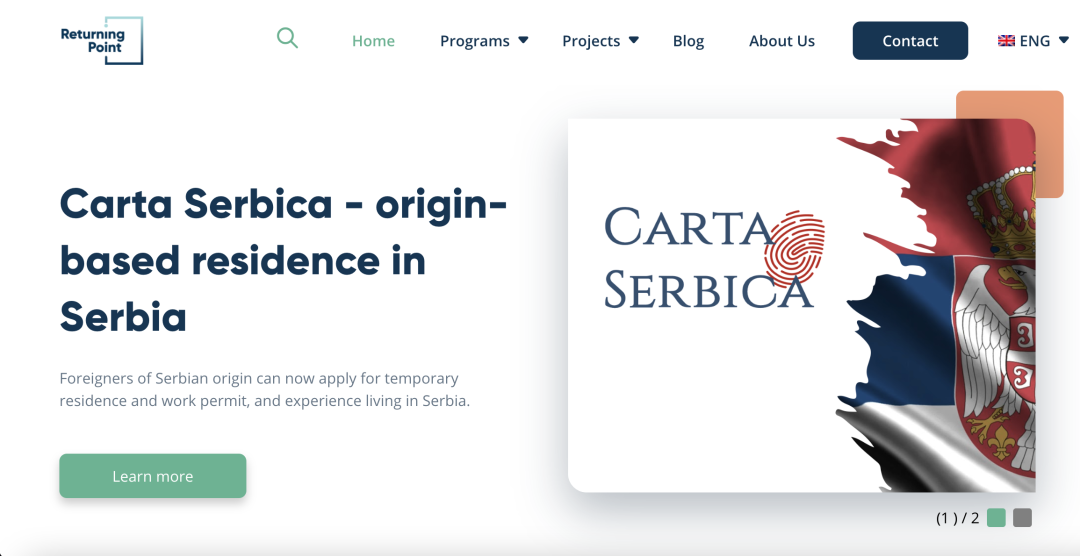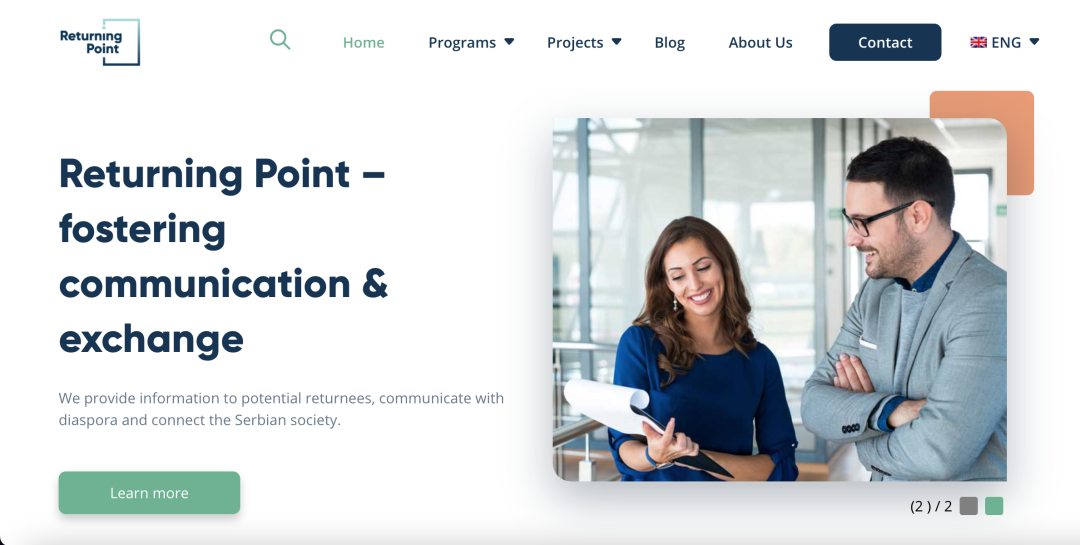Disclaimer:
Please be aware that the content herein has not been peer reviewed. It consists of personal reflections, insights, and learnings of the contributor(s). It may not be exhaustive, nor does it aim to be authoritative knowledge.
Overview
Prepared by (Name of the experimenter)
Kristina Nikolic
On date (Day/Month/Year)
29/9/2023
Current status of experimental activity
Implementation Stage
What portfolio does this activity correspond to? If any
Depopulation portfolio within UNDP country office in Serbia
What is the frontier challenge does this activity responds to?
Depopulation of Serbia (including topics such as: Circular migration; migration away from Serbia and (Re-)connecting with Serbia’s large diaspora through an agile platform
What is the learning question(from your action learning plan) is this activity related to?
How to support the growth phase of the newly established organization Returning Point which was incubated as a UNDP project in 2021?
Returning Point is a program for circular migration that went from the mapped initiative to the project that UNDP incubated through the Initiation plan to a stand-alone organization with which UNDP is entering in a new type of partnership. This entry point of the portfolio went through the entire learning cycle during these Lab years [REDACTED_PHONE]): Sense, Explore, Test, and Grow. This entry point continued in 2022 as a spinoff that we supported and guided as it grew into an independent and standalone organization.
https://www.undp.org/serbia/blog/how-returning-point-building-bridges-between-serbia-and-its-diaspora
Please categorize the type that best identifies this experimental activity:
Pre Experimental (Trial and erros, prototype, a/b testing)
Which sector are you partnering with for this activity? Please select all that apply
United Nations agency, Public Sector, Private Sector, Civil Society/ NGOs
Please list the names of partners mentioned in the previous question:
UN agency: close cooperation with UNFPA
Public Sector: Prime Minister’s office, Ministry of Foreign Affairs, Diaspora office and other relevant Government bodies, Science technology park, Westminster Foundation for Democracy (WFD)
Private Sector: InfoStud (partnered with a job posting website to identify job offers that are relevant for the Serbian diaspora there were advertised on Returning Point website)
Civil Society/NGOs: Serbian Entrepreneurs
Design
What is the specific learning intent of the activity?
● How to build a systemic solution to address the lack of trust between the Serbian diaspora and the institutions in Serbia and help them engage in co-creation to develop a portfolio of services to encourage diaspora’s contributions to the society at home?
● How does the relationship with diaspora change when you offer different types of services, especially when those services are so much needed and relevant in the times we live in? (like the COVID-19 vaccination, digital guide to return, or even a full concierge service to assist you in finding a new job or relocating/moving your entire family)?
● What will happen if we open new two-way pathways of communication with the diaspora, potential returnees and all the successful individuals who have already returned to Serbia to work and live here?
● What does a different kind of communication with a formal or informal tone mean for our diaspora?
What if we start to openly share stories of return and create a sense of community around the narrative of circular migration, migration by choice?
● What does it mean to return to your home country during the COVID-19 crisis? What does WFH mean, when Home is Serbia?
What is your hypothesis? IF... THEN....
If there are is a one-stop shop offering solutions for the needs of the Serbian diaspora, then Serbian diaspora would engage more with and contribute to the Serbian society
Does the activity use a control group for comparison?
No, it does not use a control group
How is the intervention assigned to different groups in your experiment?
Other
Describe which actions will you take to test your hypothesis:
· First UNDP Serbia and UNDP Serbia Accelerator Labs incubated Returning Point as an embryonic organization and trained them to become a reliable partner who can deliver for the needs of project using UNDP’s 18 month initiation plan
· Using portfolio approach to identify and activate various entry points to ultimately crate an organization fit for the needs of the Serbian diaspora
What is the unit of analysis of this experimental activity?
Entry point/intervention within the Depopulation Portfolio
Results
Was the original hypothesis (If.. then) proven or disproven?
· Engagement from the diaspora/ex-diaspora is increasing (Numbers of users, followers and subscribers to Returning Point’s activities is growing and Viber community is growing)
· Changes to laws to help diaspora engagement have happened (Carta Serbica, etc.) and were well received
Do you have observations about the methodology chosen for the experiment? What would you change?
· Priorities could have been clearer in terms of the choice of entry point according to portfolio logic
From design to results, how long did this activity take? (Time in months)
40 months (and continuing)
What were the actual monetary resources invested in this activity? (Amount in USD)
n/a
Does this activity have a follow up or a next stage? Please explain
· We managed to build a successful spin-off and a partner to help us in tackling further issues of the Serbian diaspora and new ways of working Lab
· Returning Point is no longer incubating and is now an independent, stand-alone organization with a stable team and procedures, which continued work on its initial objectives and is expanding into new areas
· While still partnered with UNDP, it built partnerships with organizations like WFD (Westminster fund for democracy) and is building rapport with GIZ (German government’s development aid agency) and SIDA (Swedish development aid agency)
Is this experiment planned to scale? How? With whom?
· Yes, Returning Point was built to scale in tackling further issues related to the Serbian diaspora and circular migrations by engaging with UNDP, as well as other public and private organizations within and outside Serbia
Please include any supporting images that could be used to showcase this activity
Please add any supporting links that describe the planning, implementation, results of learning of this activity? For example a tweet, a blog, or a report.
Learning
What do you know now about the action plan learning question that you did not know before? What were your main learnings during this experiment?
· Building trust in institutions through organizations that have clear communication and well thought out entry points is key
· Diaspora and returnees are diverse sets of people and any one-to-many communication strategy can be difficult due to their varied interests. The most well-received activities were the ones with direct and wide benefits (e.g. changes in legislation that affect everybody)
· It is important to have a team comprised of people with both the institutional knowledge of the state and those with experience of living abroad
· When devising programs, it is important to source ideas from future beneficiaries, but it is crucial that policy proposals are actionable and take account of the reality of institutions
· UNDP’s experience with local institutions was invaluable in devising actionable programs
What were the main obstacles and challenges you encountered during this activity?
· The main obstacle was the low trust between the Serbian diaspora and the Serbian institutions due to many failed similar initiatives and the widespread perception that the state institutions “do not care”
· Many topics tackled by the initiative were sensitive and needed to be communicated and handled with care
· Building and up-skilling the team and organization was a challenge due to the lack of experience in some challenging topics
· Trying new approaches always faces institutional headwinds and initial resistance
· Important not to just take on the work of existing government bodies, but be able to be a satellite organization which will continue to be agile and innovate
Who at UNDP might benefit from the results of this experimental activity? Why?
· Colleagues working on topics related to Migration, Depopulation and connection with Diaspora
· Colleagues trying to set up new similar spin-off organizations to help with UNDP objectives
Who outside UNDP might benefit from the results of this experiment? and why?
· Governments seeking to establish connections with their diasporas
· International community
· All relevant stakeholders
Did this experiment require iterations? If so, how many and what did you change/adjust along the way? and why?
· Yes, there were constant iterations in line with portfolio logic
· Gradual opening of entry points and activities in line with the growth of the team and feedback from stakeholders
· Iterations of various existing activities (e.g. podcast) and “products” (e.g. guides) in line with feedback as well as changing leadership of the organization




 5Gender equality
5Gender equality 8Decent work and economic growth
8Decent work and economic growth 9Industry, innovation and infrastructure
9Industry, innovation and infrastructure 11Sustainable cities and communities
11Sustainable cities and communities 17Partnerships for the goals
17Partnerships for the goals
Comments
Log in to add a comment or reply.